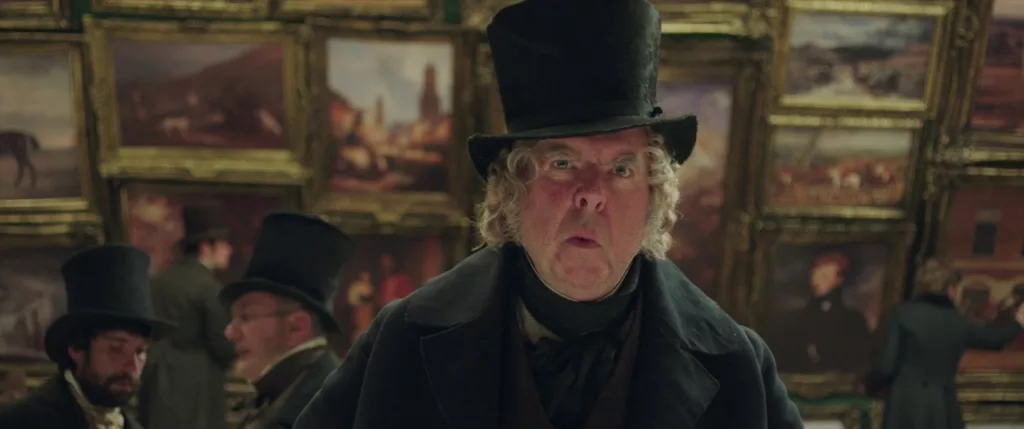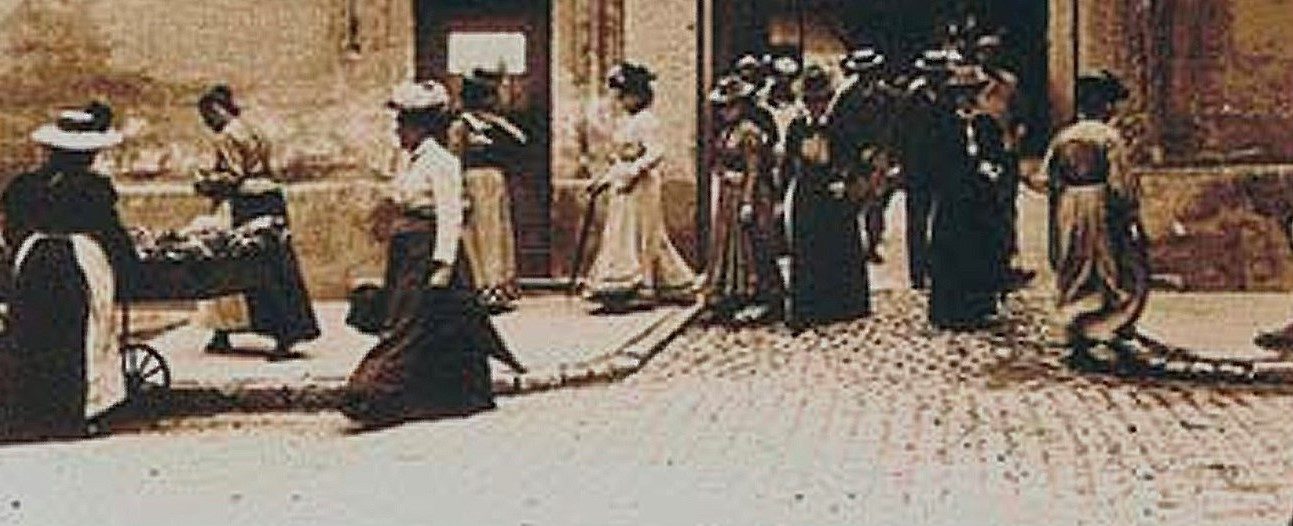United Kingdom, France, Germany, Belgium, United States, 2014
Directed by Mike Leigh
With Timothy Spall (Joseph Mallord William Turner), Paul Jesson (William Turner), Marion Bailey (Mrs. Booth), Dorothy Atkinson (Hannah Danby)

This is not a cradle-to-grave biopic: the Joseph Mallord William Turner painter the audience meets is in his early 50s and sits firmly at the firmament of the British arts, a lauded and influential master even though in this 1820s decade eyebrows start to raise and criticism to get vocal. Both his temperamental quirks and his stunning, actually groundbreaking approach he has taken to the rendering of light and the painting of color since 1818-1819 can hardly pass unnoticed and even less get readily accepted. The film records how Turner would keep painting his own, innovative, luminous manner and behaving in his own, gruff, eccentric fashion till his death in 1851.
This is mainly an episodic narrative, not quite a puzzle designed by a time-juggling editing – it is quite linear, dispensing with flashbacks or overlapping scenes – but nevertheless a motley collection of vignettes and events that are strung one after the other in a scattershot way. The film swiftly hops from one aspect of Turner’s life to another, capturing either fleetingly or to the contrary with intense focus moments that add up to a vivid and wide capture of a man’s complex and eventful life without the overriding and rationalized frame of thought-through narrative.
Still, “Mr. Turner” can be divided in two parts, each built around a figure the painter is deeply attached and indeed tending to organize part of his daily life even as he is busy exploring his vision of painting and dealing with colleagues and a wider society increasingly convinced he is boxing himself into a dead end. First comes the beloved and supportive figure of the father, eager despite his old age and physical ailments to assist the talented son in his work or in his relations with the rest of the world, be it would-be customers or a peeved and petulant divorced wife. But the benevolent and jovial William Turner soon dies (the year is 1829) and a huge part of Turner’s world, anchored in the throbbing city of London, suddenly collapses.
However, he later reconstructs another section of his world, surprisingly, for the audience and perhaps even to his own eyes, since the film has made plain how little romance can fit his mindset and habits, but as willfully as he usually works in his studio and navigates the world. Traveling to Margate he meets a feisty landlady renting rooms for tourists eager to enjoy the seaside. And he keeps coming back to the resort, forging a close relationship with Mrs. Booth, with whom he eventually lives incognito in Chelsea, a clearly far merrier and better couple life than what he experienced before, till he dies.
Travels matter a lot in Turner’s life. Indeed, the film’s first scene showing him takes place in a quaint, nearly hackneyed, Dutch landscape, where two women are pictured in a very long shot appearing near a windmill, then are followed while they keep walking and chattering until they come close to the camera and move before it, but are dropped out of the frame once the panning camera has noticed a distant black figure busy with sketching the windmill and the sunset. It has started early – he was 26 when he visited Scotland and Switzerland – and will never stop. To him, art would not be possible without watching the wider world and taking stock of the sheer variety of landscapes and painting traditions as well as the constant and magical kaleidoscope sunlight and waves are across latitudes and longitudes. And he can go at great lengths to grasp what water and sun look: he has himself strapped to the mast of a ship so that he can paint a snowstorm precisely and effusively hosts a woman physicist researching the riddle of the natural colors a prism reveals.
The effect his observations had on his style are well-known and widely admired today – but the film through a swift series of scathing scenes emphasizes how the public and the elite, even among his colleagues, were baffled and appalled. The editing as readily displays the rage of the artist and his eagerness to keep painting his way undaunted, even quite provocatively. The last part of Turner’s life is a stubborn exploration of the path he has designed for himself and his wider independent, maverick streak, prompting him for instance to bluntly reject the offer of an enthusiastic businessman to buy all his work at a hefty price. Counterbalancing this confrontational mode are the quiet scenes of his new domestic life with Mrs. Booth, even when illness takes an increasing toll on the man’s ability – and arguably, especially because illness allows his routines to be inflected by the tenderness and the thoughtfulness of the lady. He can die truly peacefully.
But the film does not end with a funeral or whatever kind of respectful eulogistic note. It brings back into focus the first female character of the film, Turner’s diffident and devoted housekeeper, Hannah Danby. She has been helping him all along and was also the female body his horny needs shamelessly used for their vile satisfaction. Yet he would not allow her to ever meet Mrs. Booth and of course would never let her know he lives in Chelsea. The poor maid, with her slightly twisted and bent torso, a perennially cocked head, and wary gazes, has only been a tool more than a companion to the painter even though she was keen to view him in intenser, keener ways, tinged with tenderness, awe, love. Betrayed and humbled, she is finally shot pacing helpless and despondent the dead master’s studio: the coda is poignant and is the ultimate, bitter, reminder of how flawed Turner was.
This is precisely where the film has been all along a rather awkward work to grasp and enjoy. Refusing any idealistic or romantic vision, the film too readily casts the painter as thoroughly obnoxious. Neither odd fits of generosity or the seaside romance dampen much the feeling Turner was ruthless, pert, and querulous to a fault. The endless grunts and constantly grumpy mien of actor Timothy Spall do not help but instead hammer this negative portrayal into the minds of the audience relentlessly – a bit baffling if appealing in the first shots, his stern grimacing and angry grumbling end up wearying seriously. Irreverence may be welcome in the biopic genre but in this case it feels like a petty obsession playing for too long.
The film can also look lacking a real center: its episodic nature turns Turner’s biography into a desultory catalog of quite uneven moments, some terrific, others shallow, some revealing, others futile. But maybe the story about the prism tells the real point of the work written and directed by veteran filmmaker Mike Leigh: this was not about articulating a neat, predetermined vision of a life, but to decompose the various hues, shades, elements, characteristics of a singular painter. Turner’s views on light and colors are duly noted but also celebrated the most wonderful way: the action and the characters bathe in a delicate and constant warm cinematography from the first shot onward. Sunsets, sunrises, sun rays are gorgeous and light is cleverly resplendent even indoors thanks to the flair of director of photography Dick Pope.

